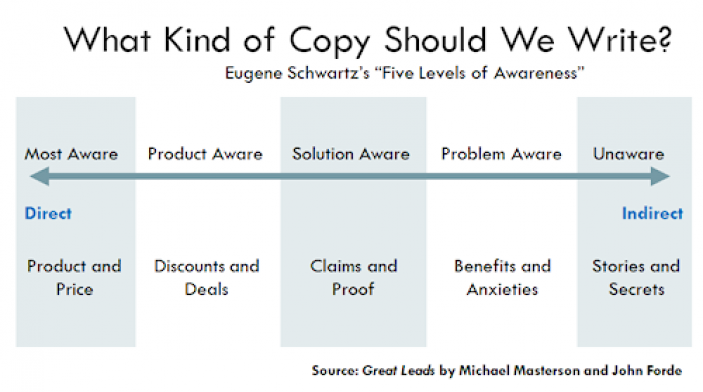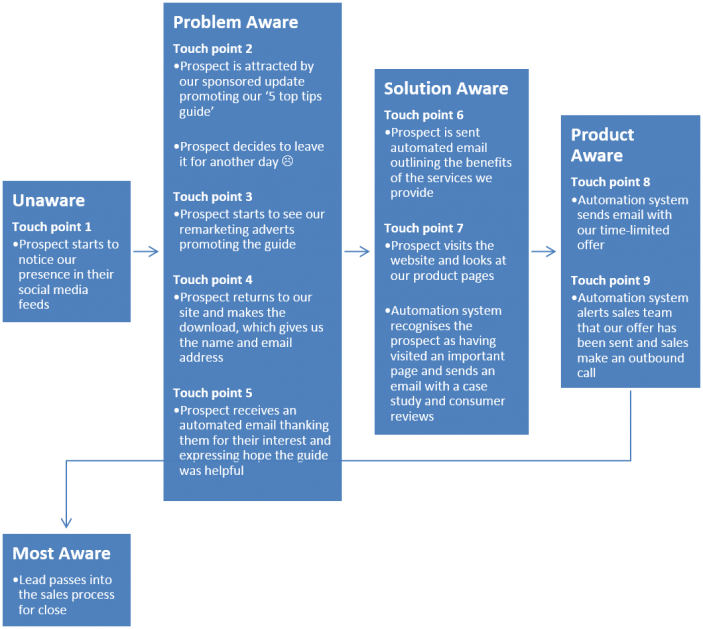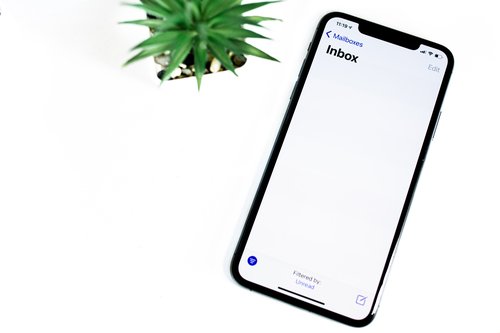Seven is the magic number
How many times do you need to touch a prospect to make a sale? For anybody to buy 'off the bat' in B2B is rare.
The consideration process is long and there can be multiple stakeholders involved, so we have to create multiple touch points to move people along from awareness that we exist to understanding what we do and trusting in our ability to deliver it.
Regardless of where the initial lead comes from, we have to develop the opportunity and move it smoothly through the sales funnel. Research shows that if we have a strategy in place to touch the prospect at least seven times, we significantly increase our chances of success.
Case Study: Peer to Peer Business Lender
How we developed a unique targeting approach and improved lead volumes from direct marketing by more than 80%.
Our challenges in doing this are two fold:
- How to identify which visitors are where in the buying cycle
- How to serve the right content at the right time and move the prospect along the path to becoming a paying customer
The answers lie in the clues implicit in online behaviours, which we can use to decide what content to serve and when.
Identifying the place in the buying cycle
Copywriter, Eugene Schwartz famously created a spectrum of awareness to guide his writing, ranging from unaware to most aware, and we can use the same framework to build our nurturing strategy.

The significant majority of people that see our content or alight on our websites for the first time will be unfamiliar with us as brands. They probably have a curiosity about a topic or a problem they are trying to solve and are generally browsing the web in search of answers. Schwartz called these the Unaware and the Problem Aware.
These users will likely hit our sites from a search engine using a general search term or via a referral link and will make an instant judgement on whether they are in the right place. Research suggests that this decision is made in well under 10 seconds.

Case Study: PrimeStox
How we helped PrimeStox treble registrations while reducing spend in just two months.
We have to get the right message in front of these visitors quickly. The best way to do this is by anticipating the problem they are trying to solve. Solution related content that satisfies the curiosity and informs rather than sells is what is needed here. This is the role of our blog and our whitepapers. '5 top tips to' might seem a bit hackneyed as a content title now, but this is what our visitors want: good information presented in a way that is easy to read and absorb.
Our next category is the Solution Aware. These people know what they are looking for and are looking for the right provider.
Solution Aware visitors will come to our sites via more specific search terms or possibly directly if they have some prior awareness of our brands. When they get there, they are likely to dwell longer and look at our product pages. We need to make sure these pages are clear and easy to understand. This is the place to insert proof points around our claims. Case studies, testimonials and consumer reviews all serve to reassure the visitor that they are in the right place and make them confident enough to make a direct enquiry.
Finally, we get to the Product Aware and Most Aware users. These will be our direct visitors or people that come to us via a brand search. This group know what they want and are most likely to be at the point of purchase, spending extended time on our pricing and contact pages. Our job is to entice them across the line. We could consider a time limited offer at this point or, if we don't want to reduce our margins, some other form of incentive: a free consultancy session for example.
Serving tailored content
We have a few options when it comes to serving tailored content:
- Dedicated landing pages
- Dynamic web content
- Remarketing
- Pop ups
- Drip email marketing
Presenting the most valuable parts of our information via a gated landing page allows us to gather that vital user name and email address as our lead.
Where are the Unaware most likely to be? Social media is one answer, so it stands to reason that we should focus our social media promotions on our insight and added value, not our sales offers.
One size doesn't fit all with landing pages and we need to create different pages for people that are further down the sales funnel, for example, those using the more specific search terms in our PPC campaign. These pages can be more product and solution orientated. We might even consider gating some of our pricing information to identify the most aware visitors.
Dynamic web content allows us to change the page that is served on our sites based on a visitor's characteristics. A lead visits our site for the first time? Provide them with a whitepaper or educational document. A visitor's lead score indicates they are ready to buy? Offer an instant discount to close the deal. The possibilities are endless.
Remarketing can be used to serve tailored content to returning visitors. These people, by definition, have been to our site at least once already and we can tailor the remarketing ads they see to the pages they have visited. If they have been on our Home page, we can promote our '5 top tips' guide. If they have been on our product pages, we can promote our offer...and so on.
Screen pop-ups, while considered irritating by some, can be programmed to respond to visitor behaviour, including how they arrived at the site, whether they are a first time or returning visitor and what their navigation and scrolling behaviours are while there. Programmed intelligently, pop-ups can be a very effective conversion rate optimisation technique.
Once we have a lead in our system, drip email marketing sequences are our best tactic for moving a prospect gently and willingly through the sales funnel. Email marketing, backed by marketing automation, also gives us the opportunity to personalise content.
There is plenty of data available to show that emails containing the recipient's name perform better than those without. As importantly, we can customise the subject line and the content to the topic we know the recipient is interested in and their reaction to any previous contact, even if there was no reaction at all.
The key then with lead nurturing is to plan out our points of contact by aligning them with the awareness stages shown above. Here is how our multiple touch point strategy might work:

According to Marketing Sherpa, 79% of leads generated by PPC fail to convert because of poor lead nurturing techniques. Research from the Annuitas Group shows that nurtured leads make 47% larger purchases than non-nurtured leads, so, all in all, it is an absolute ROI no-brainer to invest the time in working out what our nurturing strategies should be.
Contact us if you'd like some help with yours.

Author
Neil Edwards
Neil is a Chartered Marketer and Fellow of the Chartered Institute of Marketing with many years' experience in marketing, brand and communications.
CEO / The Marketing Eye
Related Reading

Blog: Navigating the New Email Marketing Standards: What You Need to Know
by Darren Coleshill, 3 minute read

Blog: Crafting Captivating Email Newsletters: A Guide to Success
by Darren Coleshill, 4 minute read